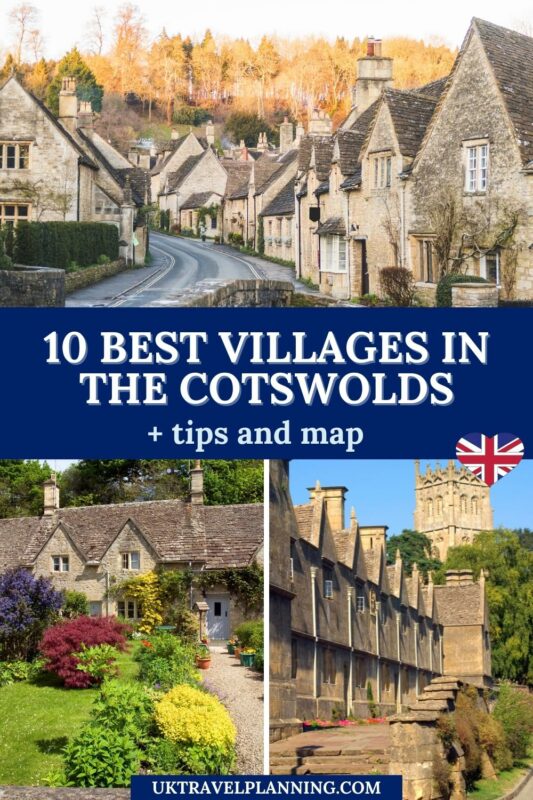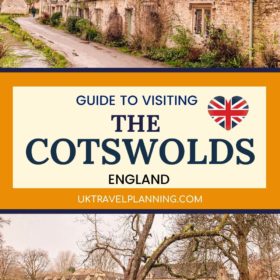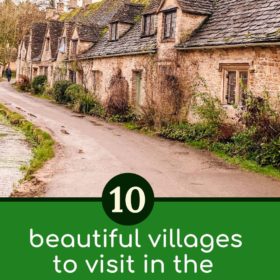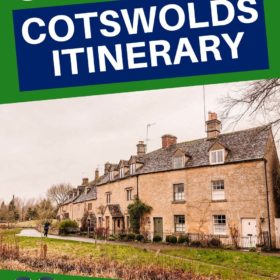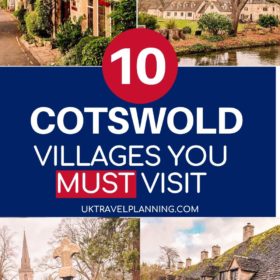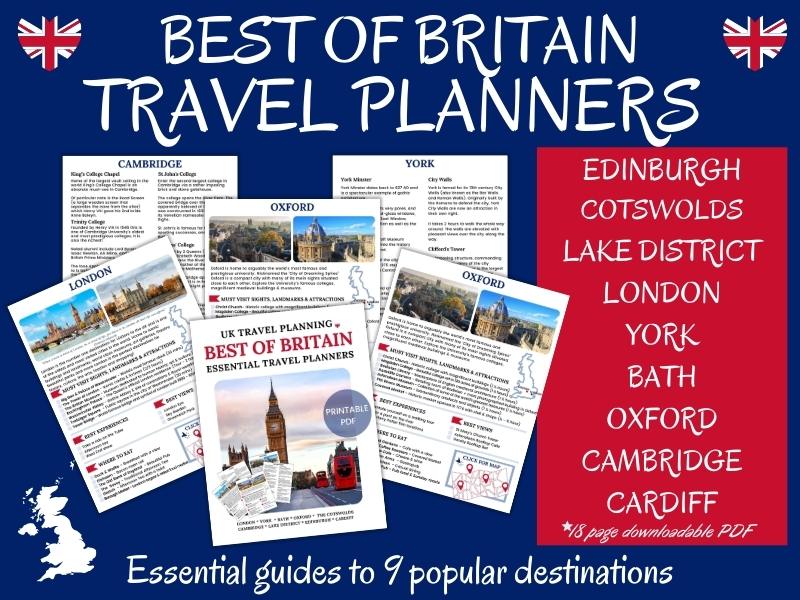If you are planning your Cotswold itinerary you may be considering which villages are must-sees. In this article, we will introduce you to 10 pretty Cotswold villages (the best villages in the Cotswolds) including what to do and see and tips to make the most of your visit.
When touring Britain making time in your itinerary to escape the cities and visit The Cotswolds — a region in central southern England that has an assortment of picturesque medieval villages – is an absolute must-do!
Running through the English counties of Gloucestershire, Oxfordshire, Warwickshire, Wiltshire, and Worcestershire the whole area — nearly 800 square miles — has been designated for conservation and deemed by the government to be an Area of Outstanding Natural Beauty (AONB).
The villages in the Cotswolds are so utterly charming, they look as though they’ve come to life right out of a storybook. Imagine weathered stone cottages nestled in the rolling green countryside. Stacked stone walls line narrow streets while sheep blithely graze in ancient English pastures.
The region is about 100 miles from London so renting a car will ensure that you’re able to tour the best Cotswold villages. If you love walking, there are miles of footpaths to explore. If antiquing or sightseeing is more your cup of tea, there’s plenty of that too.
There are dozens of villages in the Cotswolds, each with unique character and special attractions. So if you are wondering which are the prettiest Cotswolds villages, or the most adorable village, picturesque village or quaint village to ensure you don’t miss out when visiting the Cotswolds this article will provide the perfect introduction.
Our introduction to 10 of the most beautiful and best villages in the Cotswolds and will provide inspiration for your Cotswolds itinerary.
Looking for accommodation in the Cotswolds? Our guide to the best places to stay in the Cotswolds (villages and hotels) has options for every travel style and budget.
- London to the Cotswolds – Best small group guided tour options from London (& Cotswolds)
- 10 BEST VILLAGES IN THE COTSWOLDS YOU CAN'T MISS
- 1. Chipping Campden for walks (Cotswold Way), history, arts and crafts
- 2. Stow-on-the-Wold for history (Civil War), and quaint shops
- 3. Bibury for history & the most famous row of houses in the UK
- 4. Bourton-on-the-Water a perfect base for exploring the Cotswolds
- 5. The Slaughters
- 6. Castle Combe
- 7. Burford
- 8. Broadway
- 9. Lacock
- 10. Painswick
- Top tips – What you need to know if you are planning to visit the Cotswolds!
- Which of these beautiful Cotswold villages will feature in your itinerary?
London to the Cotswolds – Best small group guided tour options from London (& Cotswolds)
⭐️ If you want to make the best out of your visit to the Cotswolds but are short on time, we recommend taking a small group tour. Book with our partners and save!
GO COTSWOLDS

THE ENGLISH BUS

10 BEST VILLAGES IN THE COTSWOLDS YOU CAN’T MISS
1. Chipping Campden for walks (Cotswold Way), history, arts and crafts
When visiting the Cotswolds, consider making the lovely market town of Chipping Campden your home base. Not only is it one of the most beautiful Cotswold villages, but it’s also centrally located by the region’s northern border and is not far from several other villages.
As one of the larger towns, it offers a variety of accommodations that will suit any budget — cosy B&Bs, rustic inns or higher-end hotels.
In the Middle Ages, Chipping Campden was a thriving trading centre patronized by wealthy wool merchants. A remnant of that life is Chipping Campden’s Market Hall. It’s a 15th-century building erected in the centre of town that protected merchants from the elements while they sold their wares. You can feel the history as you step on its cobbled floor and gaze up at the vaulted ceilings.
It’s also the start or the finish of the Cotswold Way, an amazing walking trail covering 100 miles of scenic countryside and one of the best things to do in the Cotswolds. As you explore the town further, you’ll want to take your time enjoying High Street, which is lined with wheat-coloured houses and shops and boasts architecture from the 14th century up to the 17th century.
If you like historic churches, you’re in luck — Chipping Campden has several to explore. They also have a variety of very good restaurants and cosy pubs to kick back and relax in.
🏡 Where to stay in Chipping Camden
- Noel Arms – Award-winning hotel with open log fires and free parking
- Woolmarket House – A friendly welcome right in the heart of the village
Looking for accommodation in the best villages in the Cotswolds? My guide to the best places to stay in the Cotswolds (villages and hotels) has options for every travel style and budget.
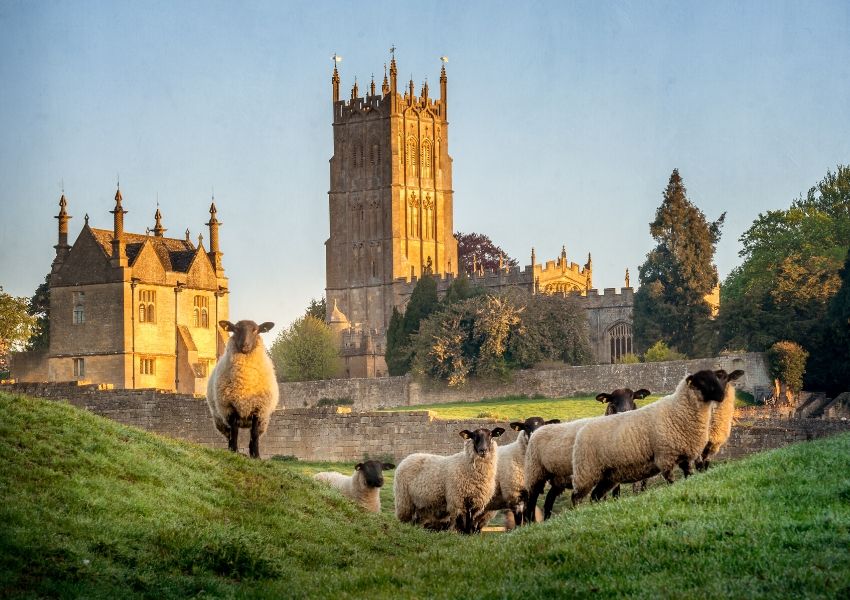
2. Stow-on-the-Wold for history (Civil War), and quaint shops
If you’re travelling from Chipping Campden, it’s about a 15-minute drive south through some especially lovely country to reach the beautiful village of Stow-on-the-Wold. It sits atop an 800-foot hill at the juncture of two mains roads.
This quaint village, like many others, began life as a market town, and today it possesses all the elements tourists seek in a Cotswold dream — scenic beauty, narrow roadways, Cotswold stone buildings and a thriving market square.
You could spend hours browsing through the town’s adorable antique shops or deciding which café is the right one for you. Stow-on-the-Wold’s tea shops are also considered to be some of the finest in the Cotswolds.
This is a very popular area, especially on weekends, so to beat the crowds, an early arrival will work in your favour. The parking is free but it’s at a premium, especially in the summer.
Don’t miss St. Edward’s Church. Built during medieval times, it looks to be plucked right out of a fairytale. If you walk around to the back, you’ll see its rather magical looking west door, flanked on either side by gnarled and thick-leaved trees. The word is that literary giant J.R.R. Tolkien himself drew inspiration from these very doors when he created The Fellowship of the Ring’s Doors of Durin.
If you’d prefer a dose of non-fiction, have a peek at the Cotswold Cricket Museum on Sheep Street. For cricket enthusiasts or cricket novices, there’s a lot of very interesting history there to learn.
🏡 Where to stay in Stow on the Wold
- The Old Stocks Inn – a 17th-century coaching inn
- Stow Lodge Hotel – Great location in the middle of the town
Looking for accommodation in these Cotswolds villages? My guide to the best places to stay in the Cotswolds (villages and hotels) has options for every travel style and budget.
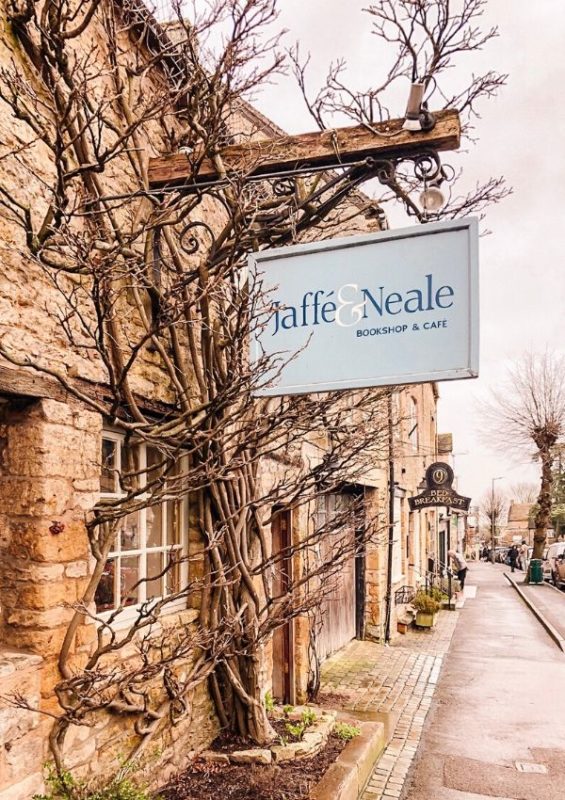
3. Bibury for history & the most famous row of houses in the UK
The village of Bibury hasn’t changed in years and that’s what people love about it. It’s quaint and picturesque, and as you admire the weathered stone cottages or stroll by the swans swimming in the River Coin, it’s easy to imagine living there hundreds of years ago. Bibury is one of the most popular villages in the Cotswolds and is a beautiful village to have as a base to further explore the area.
Arlington Row is a must-see collection of cottages in Bibury that were built in 1380 as monastic wool storage houses. Later, in the 17th century, they were converted into weavers’ cottages. Today they look much as they did back then, making Bibury unquestionably one of the prettiest Cotswold villages.
Arlington Row is one of the most photographed places in the United Kingdom. The best time to visit is either early in the day or later in the afternoon when the crowds will be at their lightest. Parking is at an absolute premium during the busy season.
There are a few places to eat in town and some shops that sell souvenirs, but the majority of your time in Bibury will be spent appreciating its tranquillity and beauty.
The Bibury Trout Farm is nearby. It is an ideal stop if you have little children who will enjoy feeding the fish. The Bibury Trout Farm has a café open during the summer months which is a pleasant and scenic place to have lunch.
🏡 Where to stay in Bibury
- The Swan Hotel – Iconic ivy-clad hotel
- The Bothy on the Green – Perfect for couples
Looking for accommodation in the best villages in the Cotswolds? My guide to the best places to stay in the Cotswolds (villages and hotels) has options for every travel style and budget.
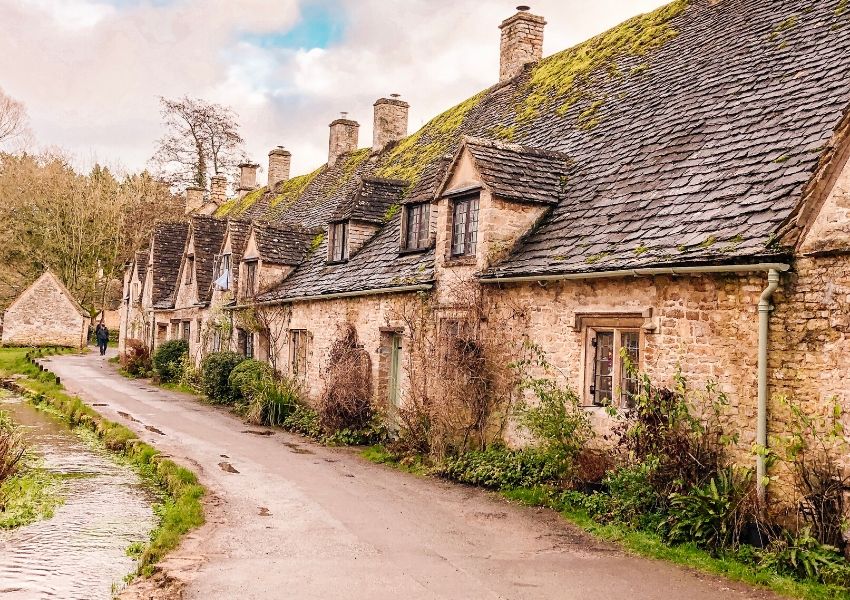
4. Bourton-on-the-Water a perfect base for exploring the Cotswolds
The Windrush River flows right through the middle of Bourton-on-the-Water — one of the most picturesque Cotswold villages. Its river is clear and shallow and enclosed on either side by low stone walls.
Weeping willows sway at its banks, and the most difficult choice you’ll have to make while visiting this little slice of heaven is which weather-beaten stone bridge is the most photogenic.
Strolling along the banks of the River Windrush, you’ll understand why they call this village the Venice of the Cotwolds. Be careful — you may get so engrossed by watching the ducks swim lazily by, you could forget all about the town’s speciality shops, restaurants and tea rooms. All are housed in picture-perfect buildings set back from the river.
If you’re a fan of vintage cars or toys from days gone by, you’ll want to stop at the Cotswold Motoring Museum.
If you’re an architecture buff, there’s The Model Village, which is a 1/9th scale replica of the Bourton-on-the-Water as it was in the 1930s. The miniature engineering that went into this model village exhibit is really something to see, as is the level of detail.
For something really different, try Birdland Park and Gardens. They have nine acres of woodlands and gardens with over 500 types of birds including flamingos, owls and penguins.
Looking for accommodation in Bourton-on-the-Water? My guide to the best places to stay in the Cotswolds (villages and hotels) has options for every travel style and budget.
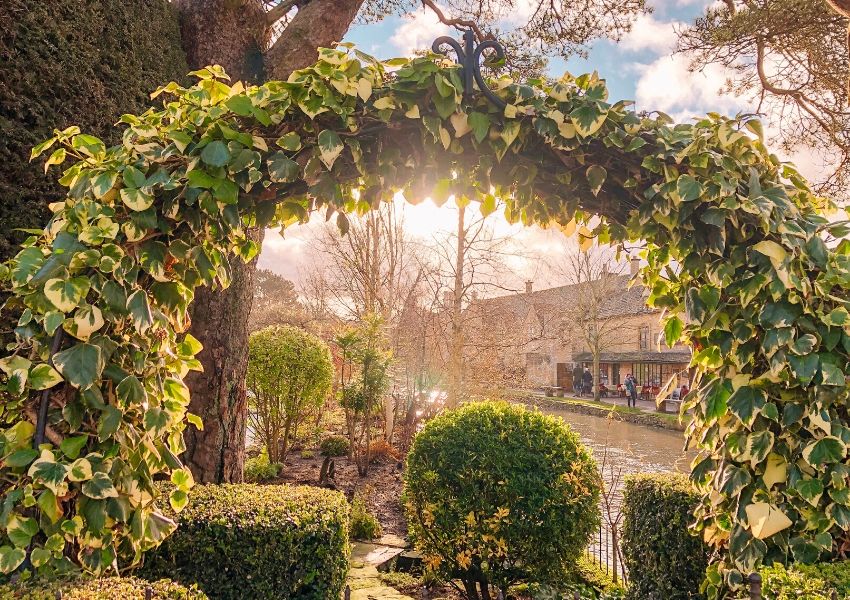
5. The Slaughters
In spite of their slightly gruesome names, the villages of Upper Slaughter and Lower Slaughter are neck and neck in terms of which one should win the prettiest Cotswold Villages contest.
At first glance, both may seem familiar, as these picturesque villages have been photographed and painted ad infinitum. Forgive their name, it comes from the Old English “slough” which means miry or muddy place—understandable given their proximity to the River Eye, a tributary of the River Windrush.
When visiting both places, the best trick is to park in Lower Slaughter. This charming hamlet dates back to the middle ages, and even appears in the Domesday Book as the settlement Scolstre.
As you explore, you’ll find romantic stone cottages decorated with flowers and walking paths shaded by trees. Wandering leisurely around the town will make you feel that you’ve left this world and gone to where Mr and Mrs Prince Charming are enjoying their happily ever after.
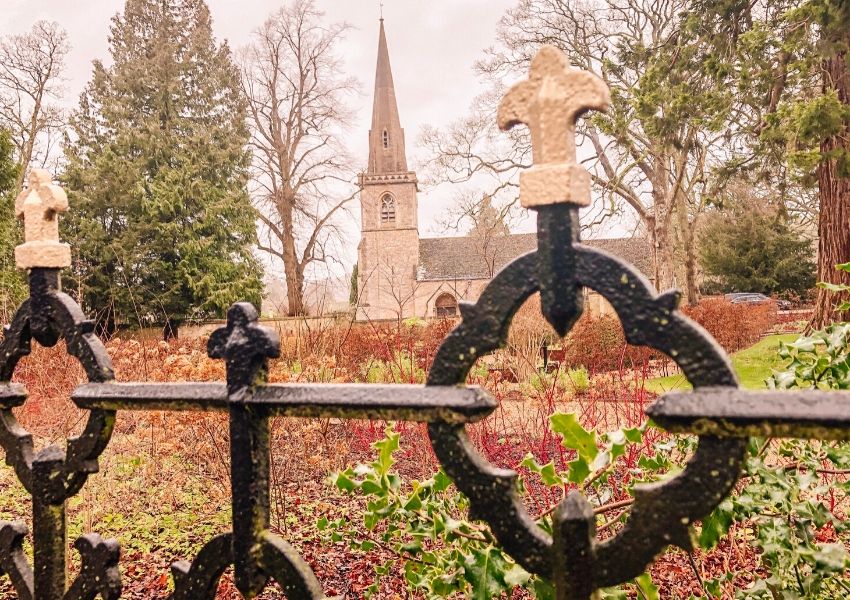
One notable attraction is the Parish Church of St. Mary. It’s a lovely old stone church with a historic cemetery. Also, the Old Mill Museum and Café is worth a visit just to see the old paddle wheel out back.
From Lower Slaughter, it’s only a 15-minute walk to the sleepy village of Upper Slaughter. You’ll find more charming golden Cotswold stone cottages and picturesque settings to enjoy.
During the summer months, you’ll want to check out The Upper Slaughter Manor, an Elizabethan manor house with lovely lawns and gardens. Before going check the website of the UK’s Historic Houses Association for more information about their tour schedule.
Looking for accommodation in these pretty Cotswolds villages? My guide to the best places to stay in the Cotswolds (villages and hotels) has options for every travel style and budget.
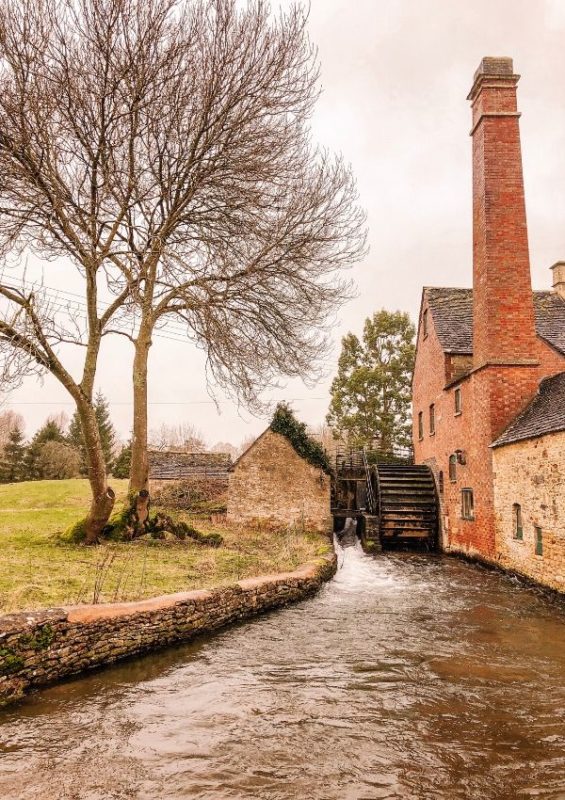
6. Castle Combe
Even though the castle in Castle Combe vanished years ago, it is surely one of the best villages in the Cotswolds to visit. Yet another contender for the most beautiful village, Castle Combe has retained its rural and picturesque charm in spite of the tourists who flock there.
Tucked in between lush green hills, Castle Combe is situated on the edge of the Bybrook River. Its history goes all the way back to when it was a fort occupied by the Romans. The Normans followed later and built their own castle.
In the Middle Ages, Castle Combe became a town of wool merchants, spinners and weavers. Today, there are two streets of charm-laden weavers’ cottages with a few pubs and churches sprinkled in. A visit to this charming village of Castle Combe is a must for anyone who likes to bask in natural beauty while appreciating the richness of English history.
Make sure you see the market cross in the town centre where the three main streets converge. It has been there since the 14th century and was formerly used for any and all town business. If you’re lucky, there will be local cake sellers that have set up tables to tempt you with some delicious freshly baked treats.
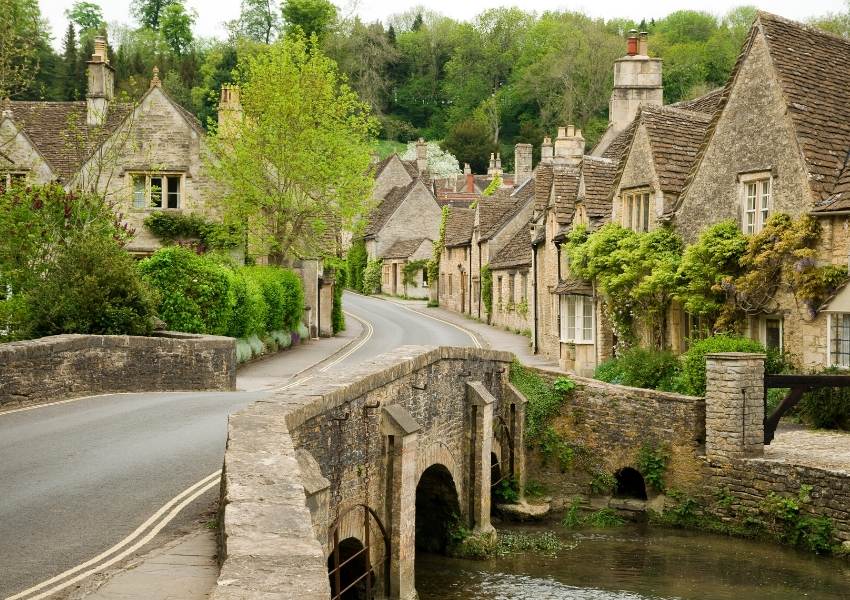
7. Burford
Known as the Gateway to the Cotswolds, the medieval village of Burford is the first of the beautiful Cotswolds villages you reach when travelling from the east. It doesn’t take long to appreciate its charms. The Windrush River winds its way through the hills and valleys of town, making it one of the most pretty Cotswold villages.
Burford is an excellent place to situate yourself because of its proximity to other picturesque villages and the many things to see and do there. For history buffs, the St. John Baptist Church dates back to the 12th century and has a churchyard dotted with weathered old gravestones.
The Tolsey Museum has been recently refurbished and is housed in a timber-framed Tudor market building originally used as a gathering place for the town’s wool merchants. Inside you’ll find a wonderful collection of English historical items and a lot of information about the area.
If antique shopping is what you’re after from your trip to Burford, then you’re in luck. There are plenty of antique shops offering a fascinating assortment of treasures.
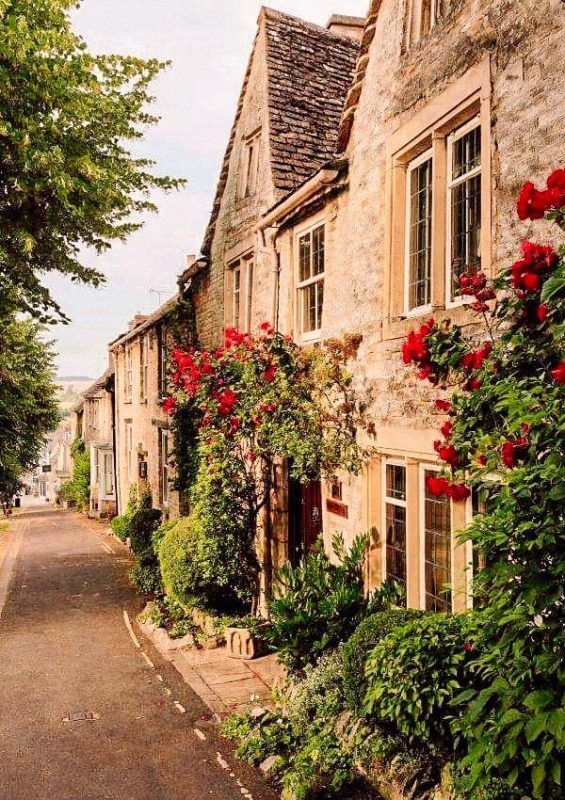
8. Broadway
Known as the Jewel of the Cotswolds, Broadway sits on a lovely piece of countryside at the bottom of Fish Hill—known as such because local monks had their fish ponds there. Today, it’s a tidy little town with lines of neat stone cottages and period houses in a setting of unparalleled beauty.
Like many other 16th century towns, Broadway was born largely out of the success of the wool trade. Its name comes from its particularly wide main road or “broad way” that ran through town.
This town distinguishes itself from the other villages because of its long association with the art world. Artists like John Singer Sargent and Francis Millet are just two famous names once captivated by the region’s charms.
If you are an art lover, head on over to Broadway’s Gordon Russell Design Museum. He was a renowned British cabinet maker, steeped in the Arts and Crafts traditions of making simple forms with excellent craftsmanship. The displays at the museum illuminate the evolution of furniture design throughout the 20th century.
If you’d rather go for a jaunt, a visit to the Broadway Tower is a must-do. As the second-highest point in the Cotswolds, it is a castle-looking structure that served as a beacon when lit back in the late 1700s.
It is smack-dab in the middle of an open field and is a rather steep, two-mile climb from Broadway’s town centre. Once there, the view is simply spectacular.
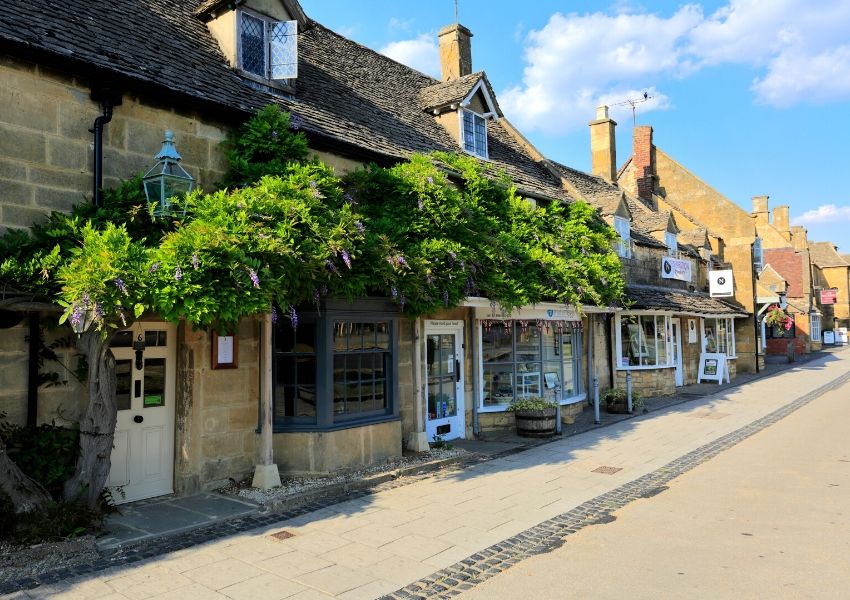
9. Lacock
When picking the best Cotswold villages to visit, Harry Potter fans simply must not leave out Lacock. Founded in 1232, Lacock is one of the best villages in the Cotswolds to explore by foot — check out the pubs, bakery and other quaint shops before you make it over to the Lacock Abbey.
Built on the foundations of a 13th-century nunnery, this country house has undergone remarkable changes over the ages which are reflected in its architecture. You could easily spend a few hours admiring the grounds and studying the remarkable building.
But what excites muggles and wizards alike is that a particularly photogenic part of the Abbey was used as a Hogwarts hallway in two of the Harry Potter movies. See if you can recognize which part.
The Cotswold village of Lacock isn’t all about the Abbey, however. The Fox Talbot Museum is there, which celebrates the photography of former resident William Henry Fox, known as a photography pioneer.
Lacock may also be familiar to fans of Downton Abbey due to its appearance in both series 5 and the recent movie.
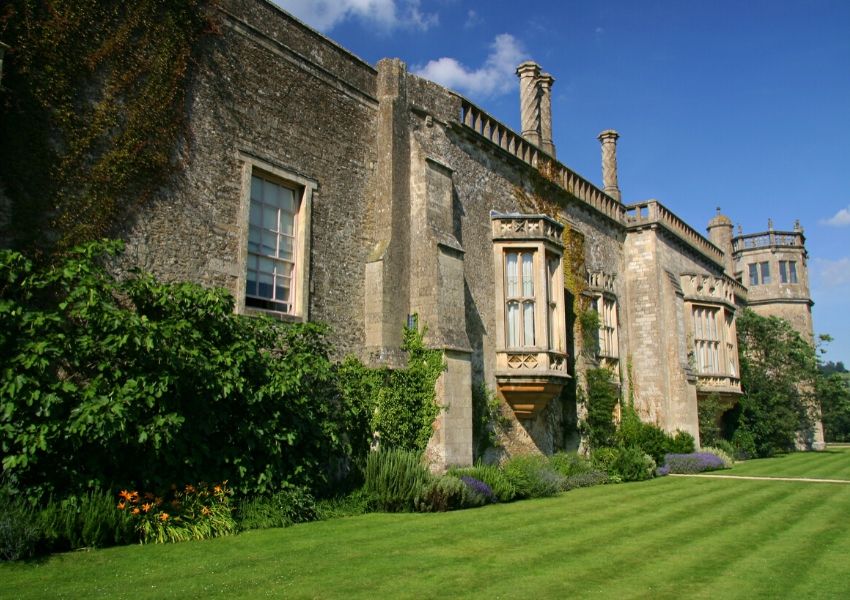
10. Painswick
Crowned with the title of The Queen of the Cotswolds, Painswick is a town born from the wool trade. It is one of the best places to visit in the Cotswolds because its stone architecture and narrow streets have been so well preserved.
But Painswick’s charms don’t end with there. It’s the proud owner of what has been called the grandest churchyard in England. St. Mary’s 15th-century churchyard is peppered with the tombs of famous Englishmen from days gone by, but the real draw is the 99 perfectly sculpted topiary yew trees. They have been trimmed and shaped in a way that makes them look otherworldly, a symbol of man’s triumph over the wildness of nature.
If the yew trees weren’t enough to satisfy your inner naturalist, then you simply must visit the Rococo Gardens. Designed in the 1740s as a setting for English garden parties, it was restored in the 1980s.
Now it is the country’s finest example of a true rococo garden—one that is fanciful and whimsical and a little over the top in its details and decoration. After you’re done tackling the hedge maze, there’s a café on the property to enjoy a nice cup of tea.
Looking for accommodation in some of the best villages in the Cotswolds? My guide to the best places to stay in the Cotswolds (villages and hotels) has options for every travel style and budget.
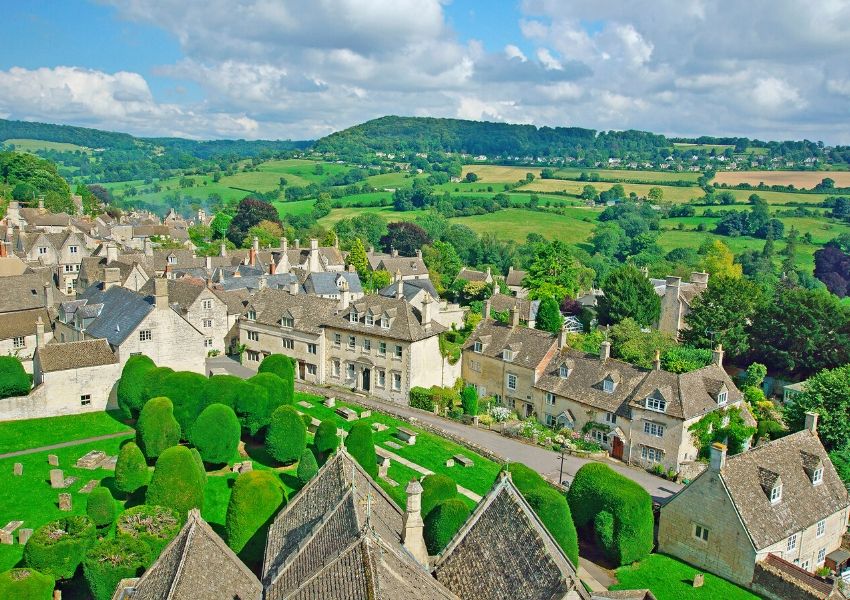
Top tips – What you need to know if you are planning to visit the Cotswolds!
These are my top tips for anyone planning to visit these villages in the Cotswolds!
- Plan your itinerary before you go!
The Cotswolds are a popular area for visitors at every time of the year and can be incredibly busy. With its thatched cottages, cosy pubs, quaint tea rooms all set in a beautiful rural setting of idyllic countryside and rolling green hills it is easy to understand why it is one of the most popular destinations in England.
It features as one of our choices in the top 21 landmarks to visit in England too!
- Book your accommodation in advance
Once you have decided on your itinerary and which Cotswold towns and villages to visit it is vital to book your accommodation to avoid disappointment.
Also, check that there is free parking near your accommodation. Parking can be tricky especially during the very busy summer months.
- Book your restaurant of choice ahead of time (and also check the hours food is served)
This applies even in January when visiting the Cotswolds (we missed out on a table at our restaurant of choice in Bourton-on-the-Water as it was fully booked)
There are lots of traditional pubs and excellent restaurants to enjoy just ensure you book ahead!
- Parking can be difficult throughout the year
There are large car parks in some of the Cotswolds villages and towns but they can be very busy. Places like Bibury are difficult to park at even in winter so go early!
Take change with you for parking machines and make sure you note the time you have before you need to return to the car.
- Don’t miss the opportunity to have a cream tea!
With lots of delightful tearooms to choose from don’t miss the opportunity to partake of a cream tea. This is essentially a scone, jam and cream accompanied with a pot of tea! Delicious!
- When is the best time to visit?
Read my seasonal and monthly guide to visiting the UK which includes information about events and activities.
Which of these beautiful Cotswold villages will feature in your itinerary?
I am sure you after reading this article you will probably want to see all of these beautiful Cotswold villages when exploring the English countryside.
It is certainly one of my favourite places to visit in England and I highly recommend booking accommodation in the Cotswolds and adding a few days into your itinerary to explore.
The Cotswolds are not easily navigated by public transport so I do recommend hiring a car.
If this is not possible there are some excellent tours which will enable you to experience some of the beauty of the area.
I recommend taking a look at the following tours
Don’t miss my Cotswold itinerary (based on our own 2-day visit to the area) coming soon. Also, check out other things to do in South West England in my top 10 picks.
We have more helpful and informative posts to help you plan your trip to the Cotswolds
- WHERE TO VISIT – Guide to the most beautiful Cotswold villages and towns many of which also feature in our choice of the most beautiful villages in England too!
- PLANNING YOUR ITINERARY – 17 things to do and see in the Cotswolds
- BEST TOURS – 7 Best Cotswolds tours from London
- PLAN YOUR TRIP – Everything you need to know is in our Cotswold Travel Guide
- WHAT ELSE IS THERE TO SEE? Check out our top 10 things to do in South West England
- WHAT TO PACK – Check out our UK packing list for all seasons
- HOW TO GET THERE – How to travel to the Cotswolds from London
- GUIDE TO VISITING ENGLAND – 9 regions to visit in England
- HISTORY LOVERS – Castle hotels in England
- PREFER A TOUR? – Guide to best UK tours 2022/3
